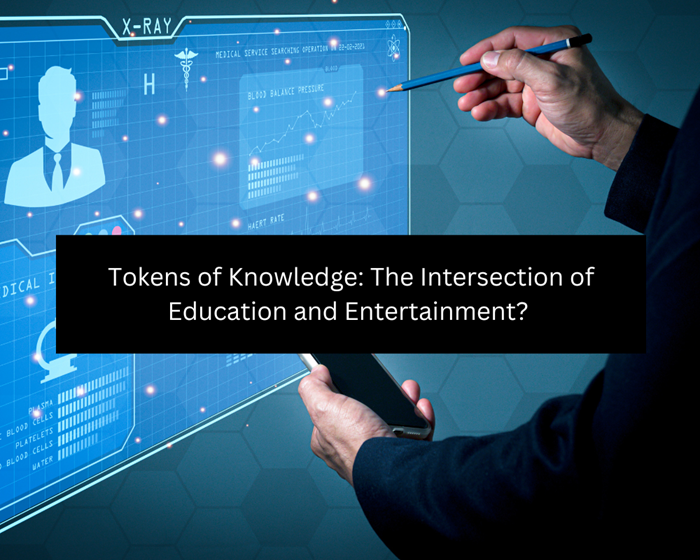Web3 and blockchain technology are considered to be revolutionary and ha brought upon a new era transcending the digital age. While the development of the internet is what started the digital age, connecting borders and offering unthinkable new opportunities, blockchain technology, and web3 have far transgressed and integrated with every pivotal industry of the world. Be it healthcare, finance, education, entertainment, or any other industry, blockchain has the potential to optimize the workflow, bringing in new opportunities for the service providers and receivers.
In such a transformative age, education is an area, still under development with arguably one of the highest potential for transformation. While digital technology has made education more interactive, it is far from its truest potential. This is where blockchain technology, NFTs in particular, comes in. NFTs have the power to completely transform the education sector and in this article, we will be exploring the different ways for NFT integration and the challenges.
NFT Tokens and Education
NFTs or Non-fungible tokens are digital tokens associated with any physical or digital real-world assets such as documents, artwork, real estate pieces, collectibles, etc. NFTs help store the relevant information associated with the assets on the blockchain, making it immutable, secure, and unique. Once registered, the NFT will act as a certificate for the ownership of the asset, along with its transaction and other relevant details.
These properties of NFTs have also been used in the healthcare industry to tokenize patient records and data to ensure seamless transfer of information in a secure and private way. Tokenized patient records can be shared with medical institutions easily and create an immutable record that cannot be manipulated, providing a solution to various problems faced by the healthcare industry.
Similarly, NFTs have the potential to not only secure certificates and merits as NFTs for easy sharing and security but also to help in offering interactive learning experiences. Let’s take a further look at how NFT tokens and blockchain technology play a role in innovations and learning in the education sector.
The Role of NFTs in Education
NFTs have an array of use cases and can be customized as needed. This flexibility of NFT makes it usable in a variety of sectors and applications. For instance, NFTs can help digitize educational certifications and at the same time, help create digital portfolios for job opportunities. Moreover, it can help enhance the learning experience by utilizing the latest AR and VR technologies for a more interactive and tailored experience. Here are some use cases of NFTs in Education.
Digitizing Education Certificates
NFTs can change the way academic achievements are showcased and recognized with the help of tokenization. Tokenization is the process of linking an asset with a digital token such as NFT and recording its details on a blockchain network. With the help of tokenization, educational certificates, degrees, and diplomas can be assigned NFT to make them tamper-proof and easily verifiable on the blockchain.
Physical documents pose several challenges, such as proof of authenticity, and complex sharing processes, and they are prone to wear and tear. However, by eliminating the need for physical certificates, NFTs can reduce the risk of fraud, streamline the verification process for potential employers, and avoid wear and tear.
Interactive Learning Experiences
NFTs also help in creating immersive and interactive learning experiences for students using innovative technologies such as AR, VR, AI, etc. With the help of virtual reality (VR), augmented reality (VR), and artificial intelligence (AI), students can utilize their unique NFTs associated with their student profiles to access the virtual environments in the metaverse to stimulate historical sides, live 3D models, and use hands-on training for an immersive and interactive experience.
These 3D models and virtual models will give the students a clearer understanding of the matter at hand while boosting focus and engagement. This application is excellently shown by a web3 gaming project called Project Lambo, that acts as a marketplace for education.
Project Lambo is a pioneering gaming word and ecosystem that blends conventional web2 gaming with web3 using cutting-edge technology such as NFTs, AR, and AI. Project Lambo has developed an Education Center, called Sheertopian Academy, that acts as a virtual learning hub within the vibrant gaming ecosystem. This academy is designed to serve as a one-stop solution for users to acquire knowledge in various fields by exploring the dystopian world and connecting with professionals and experts in different avenues. The project has also partnered with various leading experts and organizations to offer high-quality resources, interactive elements, and learning materials.
Read: The Future of IDOs: Trends and Predictions
Digital Portfolio
NFTs help in the creation of digital portfolios that help showcase the student’s skills beyond the physical documentation and certified achievements. As NFTs are dynamic, the portfolio can include a dynamic showcase of qualifications and skills. For instance, an architecture student’s portfolio can include 3D models of buildings or offer access to a virtual world designed by the student, opening a plethora of possibilities.
These NFTs then can be easily shared with employers or educational institutions offering the student the ability to showcase their skills. NFT-based portfolios offer a secure and transparent way to showcase and verify student’s accomplishments.
Micro-Credentials
Another important use case of NFTs in education is the creation of micro-credentials that represent specific skills or knowledge areas. A student can earn tokens on completing tests, tasks, courses, workshops, or any other learning experience and these tokens will act as certification for these courses that can be collected in a dynamic NFT profile. Micro-credentials help in offering a verifiable and granular way for the students to showcase their talents and expertise in niche areas, making it simpler to apply for specific job roles.
Now that we know more about the utility of NFTs in education, let’s understand the benefits that NFTs offer, making them a good addition to the industry.
Benefits of NFTs in Education
NFTs are built upon blockchain technology and inherit all its benefits including its immutability, security, and privacy. NFTs also have several other benefits, including:
Security and Authenticity
NFTs are tamper-proof and all the information is available on the blockchain network, ensuring transparency of the NFT. These tokens help certify the ownership and authenticity of digital assets, which can include certificates, credentials, student profiles, and other important information. All this information is stored on a blockchain network, making it secure and ensuring the integrity of the educational records.
Interactivity and Engagement
As discussed above, NFTs can be integrated with the latest technological developments to create an immersive and interactive learning experience for students. This property of NFT can help retain student’s attention and engage them in a more interactive experience boosting knowledge retention and understanding.
Verifiability
Several countries and academic institutions suffer from counterfeit academic records as there is no way to authenticate these documents. Even digital records can be hacked and create a problem for deserving students. NFTs can help mitigate this problem by enabling easy verification of academic achievements. All the records can be uploaded to an NFT by an authorized institution, which cannot be modified later to ensure the originality and authenticity of the documents. NFTs can help reduce the risk of credential fraud, fostering trust and security.
Flexibility
NFTs can be used to represent a variety of digital assets and serve various educational purposes because of their flexibility in integrating with different industries. For instance, an NFT can be used to store academic records and credentials, while at the same time used to create portfolios and student profiles. This flexibility of NFTs enables a variety of use cases, which will continue developing as education becomes more digitalized.
As evident, the benefits and use cases of NFTs in the education sector are limitless. However, there are various challenges associated with the integration that need to be addressed before the full potential of this integration can be achieved.
Challenges in Adoption NFTs in Education
NFTs are still relatively new additions in the digital space and have been mostly limited to the entertainment, financial, art, and real estate sectors. To fully achieve the potential of NFTs, certain challenges need to be addressed.
These challenges include:
Technical Expertise
The inner workings of NFTs are technical and require a deep understanding of the underlying technology for seamless integration. This can act as a barrier as some educational institutions might not have the resources and technical knowledge for the integration. Additionally, NFTs are still being developed and will continue to develop, which requires constant development to ensure the security and reliability of these NFTs.
Cost
NFTs can require initial investments as they might require educational institutions to invest in a blockchain project that offers such services. Moreover, in most cases, cryptocurrencies are the native currencies of these NFT projects and will require the institution to convert fiat into crypto to pay for the services.
Integration
Integrating NFTs with an educational system can be a complex process as it requires digitizing student records and transferring them to the NFT. The complexity can increase with the scale of institutions as the data that is required to be processed will also simultaneously increase. Integration issues can also be caused due to compatibility issues and can require a complete restructure of the workflow in the institute, which can be a tedious and costly process.
Standardization
NFTs are relatively new and are used scarcely in various industries. To ensure seamless integration, a large-scale standardization is required. Currently, the fragmented landscape can cause potential confusion. For instance, a student NFT will be ineffective unless the job provider and educational institutions can receive these NFTs and access the information within them. It is vital to establish industry-wide standards and guidelines to facilitate broader applications and seamless interoperability.
Future of NFTs in Education
While there are various challenges that need to be addressed, the future of NFTs in education holds immense potential and will inevitably become a core part of the industry. As the NFT technology becomes more widespread and easily accessible, the adoption will boost exponentially, considering the limitless potential and benefits it offers.
Some potential future developments for NFTs in education include:
Personalized Learning Experience
NFTs can help in the creation of customized learning pathways where the course of the subject can be tailored to individual student’s needs and interests. With this, educational institutions can have a more targeted approach for students resulting in easier understanding and boosted interest.
Digital Portfolios in Career Development
NFT-based student portfolios can help showcase specific skills dynamically, This approach will help in creating a symbiotic and direct relationship between the student and potential employers. A student can showcase their skills while employers can easily filter the applications based on the job requirements.
Micro-credentials for Continuous Learning
NFTs can boost the recognition of micro-credentials, which will enable lifelong learning and professional growth. Employees and students can continue to build on their repertoire of skills and ensure professional development in the competitive job market.
Decentralized Learning Networks
NFTs can help in the development of decentralized learning environments where students can access educational resources easily from anywhere across the globe without limiting themselves to a particular institution. This will enable an easy flow of resources and improve skill development in different avenues. Additionally, on completion of a course, the learner can acquire an NFT, which will act as a certificate for expertise in that particular area.
Final Verdict
As evident, NFTs can potentially revolutionize the education sector. It can not only optimize the shortcomings of the education sector but also create a globally-connected system that will help students, employees, and employers alike. The seamless connectivity of blockchain technology, with its security, privacy, and immutability, can be a great addition to the education sector.
While there are several challenges that need to be addressed before a global integration, some projects such as Project Lambo are already working on merging the boundaries between blockchain technology and education. The result is an interactive, entertaining, and secure way of learning and transferring knowledge, which will surely help in developing educational power on a global scale.
Author’s Bio:
Nia is a creative powerhouse with a degree in writing who thrives in entrepreneurship and marketing. She has a penchant for working on cryptocurrency projects, such as RPG NFT games, Blockchain games, and virtual games. Nia is a genuine fan of creativity and invention who likes to tell stories.



